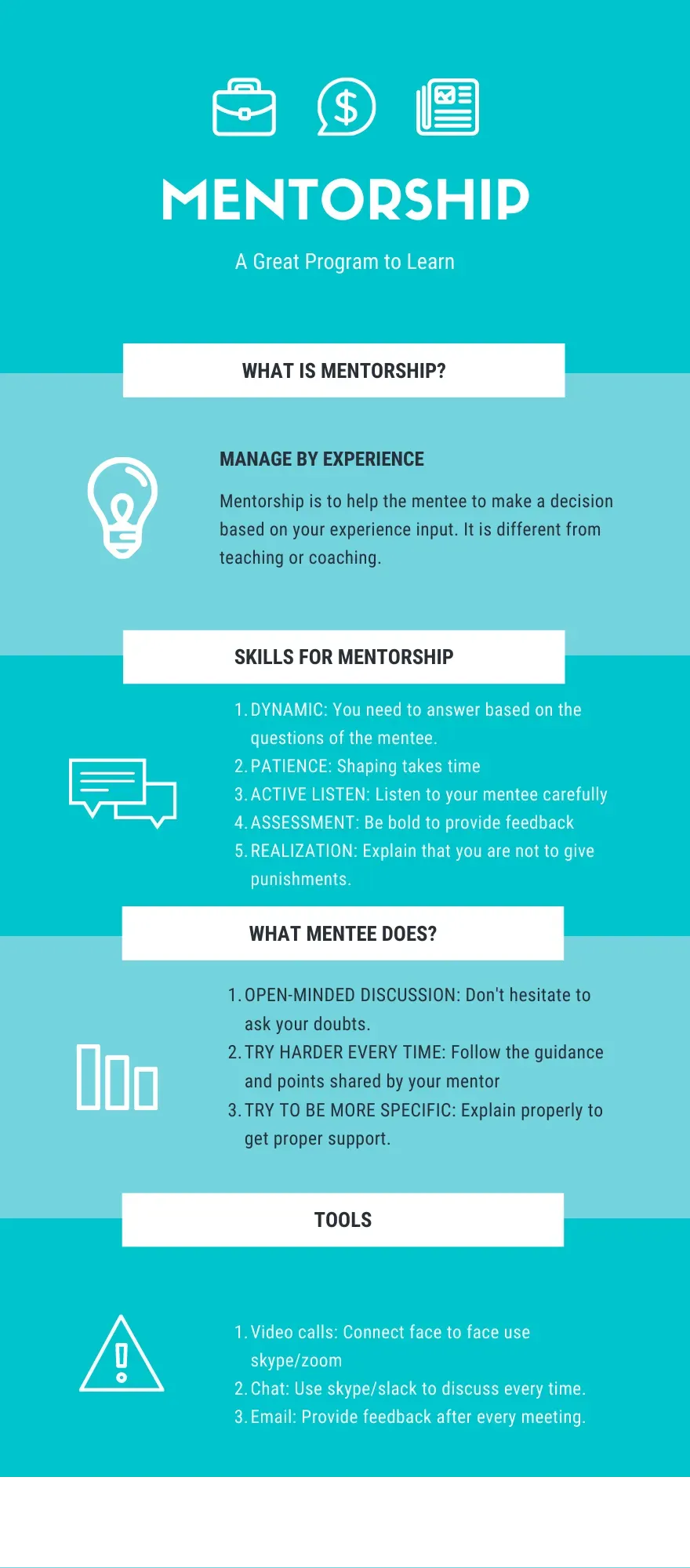
How Mentorship Can Be the Game-Changer You Need for Success
Table of Contents
- What Is Mentorship?
- What Is Done During Mentorship?
- What Are the Skills Required for Mentorship?
- What the Mentee Has To Do?
- What Are the Steps During Mentorship?
- What Are the Tools I Use in Mentoring?
- Conclusion
What Is Mentorship?
In mentorship, your job is to help the mentee to make decisions based on your inputs and not to make decisions by yourself. It is different than coaching. A coach provides a path to complete and achieve some goals. But as a mentor, you need to teach your mentee using your experience and knowledge. In that way, you are making the mentee independent.
What Is Done During Mentorship?
Mentorship is not like teaching in school, where you sit with your mentee and teach every chapter one by one. When a mentee asks you a question, it does not mean you have to answer with the complete solution in the first place. You can reply with questions, checkpoints, and a list of questions.
I don’t see mentorship as a pre-defined series of chapters to discuss with the mentee. This journey is based on instant conversation. As a mentor, you need to support your mentee based on his question. It is possible that two mentees from the same technical field will never ask similar questions.
What Are the Skills Required for Mentorship?
- Dynamic: Being a mentor is not straight forward as teaching someone. Here you don’t have an idea, what would your mentee ask. It is dynamic, on the spot. That is why mentorship is not easier. You can be more dynamic only if you have good experience in the field. If you are mentoring someone in a particular technology you should have some good experience with it. Which gives you more advantages for mentoring someone.
- Patience: A mentor must have the patience to get a reply from the mentee. Remember you are there to teach chapters one by one. You need to shape the mentee where he is weak or requires more support. You can only do it if you have patience.
- Active Listener: As a mentor, it is not only you to talk. You have to make your mentee talk about their questions and the support required.
- Assessment: A mentor must be good at assessing the mentee. You have to be bold to understand his current status. If he looks at your questions, tries to implement them in his daily routine and work.
- Realization: A mentor must learn to realize to the mentee that, you are not there to punish them for their mistakes. Your job is to make them understand how to handle it in the first place to not face such a scenario or how to handle the scenario and move forward from there.
What the Mentee Has To Do?
The mentorship program is not a one-way flow. It can not work based on only one side of the activity. When both sides, the mentor and the mentee work together it completes the mentorship.
- Open-Minded Discussion: As a mentee, you have to ask questions, suggestions for any scenario you have. It is not necessary that you should ask only high difficult questions. As a mentor, I have noticed that the mentee sometimes does not share everything every time. Reasons for that can be shyness, fear of false judgment. I always encourage my mentees to ask every tiny questions they have, because it will roll a dice to the next step.
- Try Harder and More Every Time: Every teaching class has an exam at the end to make your assessment. But in mentorship, you should consider every day as an exam. Because your mentor’s job is to assess you and find where you might require an improvement. He will give you a list of questions, checklists to complete. If you want to learn and grow, you need to follow the guidance and points shared by your mentor.
- Try to Be More Specific: Your mentor can only be able to help you if you are more specific to your problem. Remember each one of us has different kinds of issues and different levels. So, it is not necessary that your mentor has all the ideas on what you are facing. Being more specific helps your mentor to find give you proper medicine.
What Are the Steps During Mentorship?
During the mentorship program,
- I make my mentee feel human. Not like a boss and employee kind of environment.
- I make them understand that I am not here to punish you based on your mistake so you would not do the same next time.
- I always let them speak first about their problems.
- I make them understand that there must be two-way talking to identify and resolve the problem.
- Since I mentor people from the technical field, I always check their code along with them. I give them comment on their pull requests and explain what can be the correct flow.
- I help them to format a question with details to ask questions to their client, managers, and the team.
- I tell them what are the points improved and what points can be improved.
What Are the Tools I Use in Mentoring?
If you search on Google, you will find many templates to use throughout the mentorship program, some of them are useful as well. But it is not necessary that you need to use the same format and follow it thoroughly. I prefer to use simple calls, chat, and email for mentoring.
- Zoom/Skype: For video calling, sharing screen to explain in dept.
- Chat: For discussing small items which do not require video calling.
- Email: After every call, I write a list of points, positive and still to improve. In the next email, there goes appreciation if any point is being improved. I highlight the most important part, what still I am looking forward to them to improve.
Conclusion
- Mentorship is not like teaching. Mentorship can not be done by recording a video and share with everyone. Because each mentee will have a different set of questions.
- Mentorship is all about being dynamic, active participants.
- As a mentor, it is important for you to have patience, be supportive and, be an active listener.
- As a mentee, it is important to ask every question you have. It does not matter how much it is silly.
- You do not require any fancy software to run a mentorship chain.
